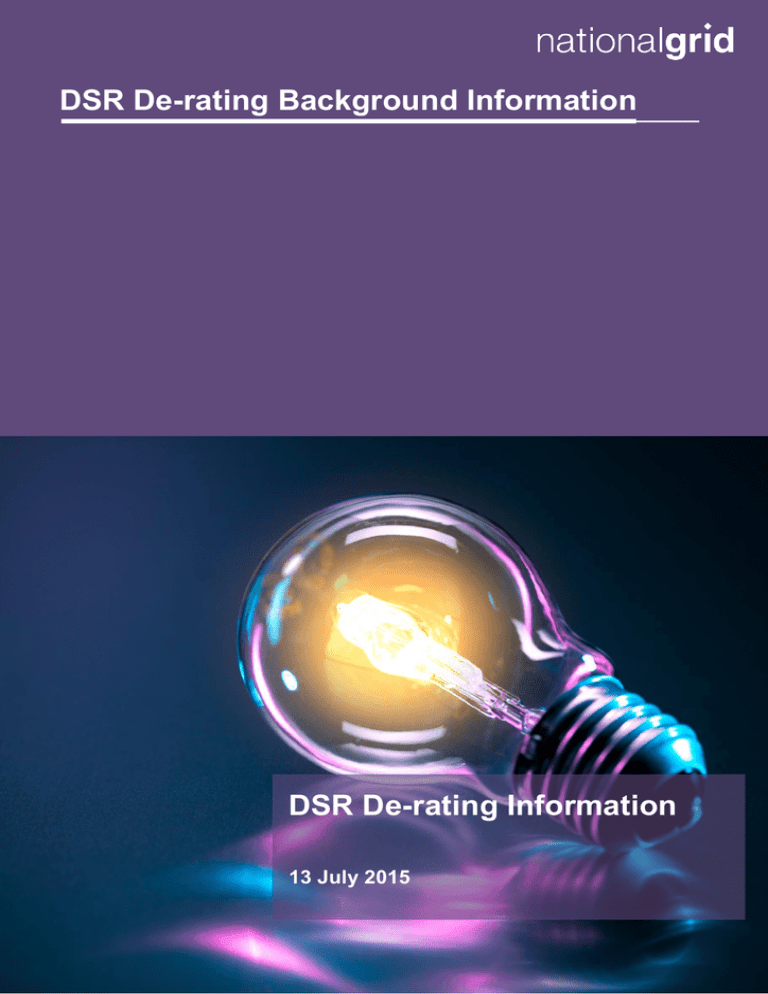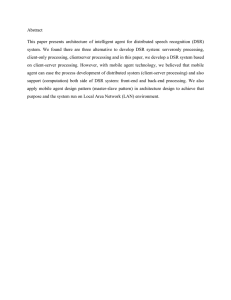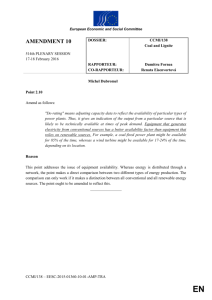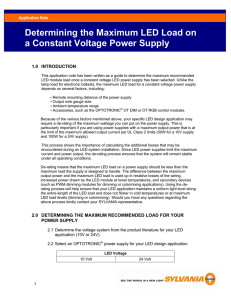
DSR De-rating Background Information
DSR De-rating Information
13 July 2015
National Grid Electricity Transmission
Page 1
DSR De-rating Information
13th July 2015
This information document must be used in conjunction with the Electricity Capacity Regulations 2014
and Capacity Market Rules 2014 (with 2015 amendments); failure to do so may result in unsuccessful
pre-qualification or failure to gain a capacity agreement in the Capacity Auction.
Copyright National Grid 2015, all rights reserved. No part of this information document may be
reproduced in any material form (including photocopying and restoring in any medium or electronic
means and whether or not transiently or incidentally) without the written permission of National Grid
except in accordance with the provisions of the Copyright, Designs and Patents Act 1988.
National Grid Electricity Transmission
Page 1
DSR De-rating Background Information
De-rating Calculation Responsibility
The Capacity Market Rules 2.3 sets out the requirements for the calculation of De-rating Factors.
Rule 2.3.1(a) requires the Delivery Body to calculate the De-rating Factor for CMUs in each
generating Technology class and 2.3.1(b) sets out the responsibility of the DB for determining the
De-rating Factor for DSR CMUs.
The Secretary of State, subject to Capacity Market Rule 2.3.1A(a,b), must determine a De-rating
Factor for each Interconnector CMU.
This document describes the process followed by the DB in fulfilling the obligations under 2.3.1 (b)
for the calculation of De-rating Factors for DSR CMU’s.
De-rating Factor Definition
2.3.4 of the Capacity Market Rules explains what a De-rating Factor is:
a. for CMUs in a Generating Technology Class, the Technology Class Weighted Average
Availability (“TCWAA”) of that Generating Technology Class;
(Covered in the Electricity Capacity Report1)
b. for DSR CMUs, the Average Availability of Non-BSC Balancing Services (“AABS”) and;
(Covered in this document)
c. for an Interconnector CMU, the Equivalent Firm Interconnector Capacity (“EFIC”) of that
CMU.
(Covered in DECC guidance2)
2.3.5 of the Capacity Market Rules explains how AABS is calculated:
b. for AABS, by determining the mean average of the declared availabilities of all Non-BSC
Balancing Services providers at real time in High Demand Settlement Periods over the
three immediately preceding Core Winter Periods, divided by their contracted volumes.
Determining Average Availability of Non-BSC Balancing
Services
STOR availability was chosen as a basis for these calculations as this is the largest, most accurate
and relevant data set available to National Grid. Availability information following settlement also
includes the effect of any utilisation failure, so this provides a more accurate view than declared
availability. Note there is a low volume of other applicable Balancing Services data available such
as FCDM (Frequency Control Demand Management) and FFR services (Firm Frequency
1
https://www.emrdeliverybody.com/Capacity%20Markets%20Document%20Library/Electricity%20Capacity%20Report%
202015.pdf (page 58-73)
2
https://www.gov.uk/government/uploads/system/uploads/attachment_data/file/439232/150629_SoS_NG_Confirmation_
of_Capacity_Auction_Parameters.pdf
National Grid Electricity Transmission
Page 2
DSR De-rating Background Information
Response) but these services are either not comparable to Capacity Market data, or the data is not
sufficient to add value to the process.
Within STOR there are three services:
1. Committed - a service provider must make the service available for all Availability
Windows within the contracted Season.
2. Flexible - this is only open to non-BM service providers and allows greater flexibility
on how many hours are made available and when that is offered; and
3. Premium Flexible - Similar to the Flexible service, although when a service
provider offers availability in a ‘premium’ availability window, National Grid
guarantees to accept a large percentage of these.
From the three STOR services only Committed STOR units were considered and used in the
calculation. The availability of Flexible units is found to be low due to the nature of the load and
hence the reason for the flexible service. When including Flexible STOR the De-rating Factor was
shown to decrease so was not used. The committed service also more closely reflects the capacity
product than the other services. Currently contracted unit data was used as this reflects the current
market rather than units that may have left the market due to low performance.
DSR De-rating Methodology
The following explains the methodology used on the data to calculate the DSR De-rating figure
(using Committed STOR availability over the most recent 3 winters at 50th percentile demand):
1. The mean average of the declared availabilities:
- The mean average of the STOR available volume or 0 if not available, where the
volume is as settled including any deemed unavailability following an Event of
Default, for the defined STOR units in the defined settlement periods.
- Units that have declared themselves unavailable will have 0 availability for the
relevant period.
- As per the STOR Standard Contract terms, units that have failed to deliver by
the end of their defined response time following a utilisation instruction (<90% of
expected volume in response time) will have 0 availability for the periods
impacted.
- Units that have delivered <90% expected volume for an instruction will have 0
availability for the remainder of the window.
- Units that have baseline generation/load at level other than agreed i.e. if a
generator metering >0MW, if a demand unit, metering < Contracted MW, will
have 0 availability for the entire window.
2. Of all Non-BSC Balancing Services: Non-BM Committed STOR units that were
contracted for the latest winter season (STOR season 8.5).
3. Over the High Demand Settlement Periods: Settlement Periods inside defined STOR
windows between 7 am and 7pm where the GB peak demand for the day was greater
than the 50th percentile of demands for that winter (November to March). The definition
National Grid Electricity Transmission
Page 3
DSR De-rating Background Information
of High Demand Settlement Periods is that used in the ECR (Electricity Capacity
Report)3.
4. For the three immediately preceding Core Winter Periods: on week days between
December and February.
5. Divided by their contracted volumes: settlement period STOR contract volume.
Calculated DSR De-rating Factors
Using the above methodology the calculated De-rating Factors were:
2014
2015
89.70%
86.80%
The DSR De-rating Factor for the 2015 Auction Window is 2.9% lower than that calculated for
2014. There are a number of possible reasons why a reduction is seen in the De-rating Factors
compared with last year; the market is well supplied causing the prices to reduce in the market
thus creating an incentive for some providers to move to evolving services such as fast reserve.
3
https://www.emrdeliverybody.com/Capacity%20Markets%20Document%20Library/Electricity%20Capacity%20Report%
202015.pdf
National Grid Electricity Transmission
Page 4



